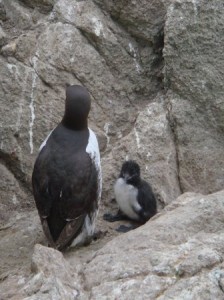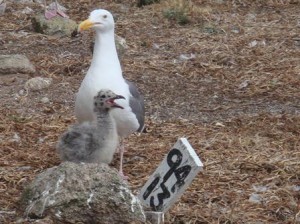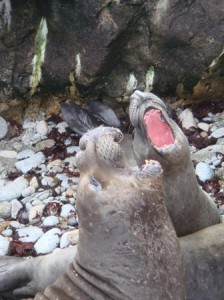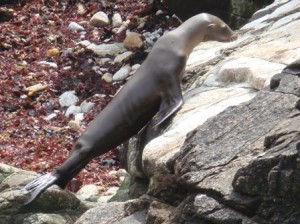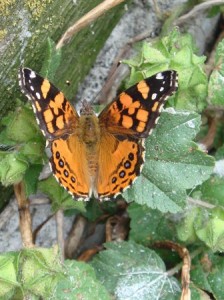Well, for the most part, the last couple of days have continued to be routine. Media visits are over, the weather is being very cooperative, and the boat that was scheduled for tomorrow is actually coming tomorrow, bringing Pete back to the island, along with a whole lot of new food that we ordered yesterday.
In addition to routine, though, the past couple of days have been extremely depressing, because it’s in the last couple of days that we are starting to realize that the Common Murres are having one of their worst reproductive years EVER. Way back toward the beginning of my stay here, I put up a picture of a baby murre chick. This picture at left is what some of the chicks look like now, sleek and a little bigger, getting ready to fledge. The problem is, hardly any of them have made it to this stage. In my plot, of over 200 breeding pair sites, only 3 chicks remain. In the plot we monitor for diet watch, more than half the birds are gone, and the chicks are dwindling, as evidenced by the slower and slower rate of feeds (Russ and I spent two hours in the blind today, and saw five feeds–that’s REALLY slow).
Today, it appeared as though one chick was going to fledge; you can tell because the chick and the father go together to the water’s edge to jump in together. Overall, though, it looks like only a handful will even survive to enter the water.
Western Gulls aren’t doing phenomenally well this year either. I haven’t talked much about the gull study I’m doing, so I’ll write about it quickly here. There are four monitored gull plots on the island–one of them, k plot, is mine. There may be hundreds of nesting gulls in one plot, but we only monitor the ones that are banded, because the banded birds are of a known age. At the beginning of seabird season, those banded birds that have returned to nest in a plot are each given markers, like the sign in this picture. This marker, which reads “94/13” indicates that this gull was born in 1994, and is the 13th gull from 1994 to return to breed in that plot. That way, we can monitor not only age of the breeding gulls, but also site fidelity (do they return to the same place to breed?) and breeding success. In a good year, a gull will successfully fledge one out of three chicks. K-plot, my plot, usually has low productivity, but this year it’s really low. I have only a handful of gull chicks left to band, and we’ll just have to wait and see how many of the banded ones survive to the end of the season.
On a brighter note, elephant seals are beginning to return to the island in greater numbers. During my last elephant seal resight, yesterday, I had eight animals in just one site (I monitor three sites) that had tags or stamps.
Although the immature individuals and the females have been hanging around the island for a while now, it’s the large males that have started to show up in the past few days, and they make their presence known, mostly by being extremely noisy. The sound they make is somewhere between a growl and a belch, but it’s not a ridiculous amont of volume.
Right now, while the animals are molting, a large number of males can gather together in a small space without much problem. During breeding season, though, you would never see something like this–alpha bull males take over an entire area, and it’s rare that any other male is even allowed to hang around the vicinity.
Zalophus (California Sea Lions) are also starting to appear in greater numbers on the island. Much of this has to do with the fact that their pups, which have been appearing over the last month, are getting big enough to swim around now, and haul out onto beaches by themselves. Zalophus are graceful animals (at least, the females and immatures are; adult males are cumbersome looking creatures), and they have a LOT of mobility. It’s amazing how high they can climb–you sometimes see them up on cliffsides, in amongst the birds, a couple hundred feet from the water. In constrast to elephant seals, their tails somewhat resemble back legs in function, and their flippers are long enough to use like arms.
Finally, I saw a butterfly yesterday, my first in four weeks on the island.
It’s hard to believe that four weeks have already gone by, half my time on the island has disappeared already. And, now that a multiple of two weeks has passed, a boat is coming, so tomorrow will be fairly busy. Saturday is chore day (no time off for 4th of July, obviously!), and in addition to a boat landing, I have to do a little bit of census work for cormorants and murres. I’ve also started doing a lot of data inputting in my free time, trying to keep us up to speed on backing up all this data we collect.
AND, with all the fresh fruit that’s coming in tomorrow, I plan to make a 4th of July cake (using strawberries and blueberries, of course), so we’ll see how it turns out.
That’s all for now! Bedtime.
Best,
Eleanor

